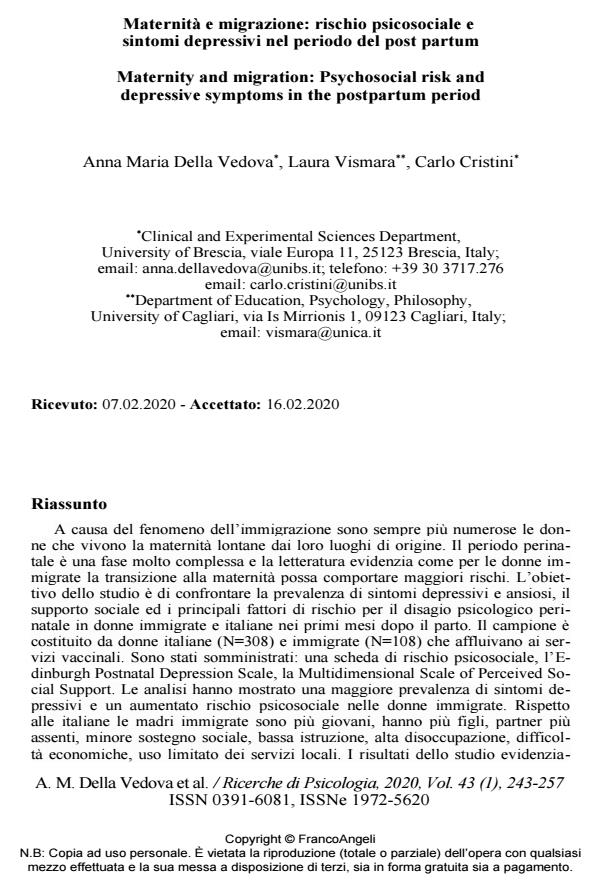Maternity and migration: Psychosocial risk and depressive symptoms in the postpartum period
Journal title RICERCHE DI PSICOLOGIA
Author/s Anna Maria Della Vedova, Laura Vismara, Carlo Cristini
Publishing Year 2020 Issue 2020/1
Language Italian Pages 15 P. 243-257 File size 217 KB
DOI 10.3280/RIP2020-001011
DOI is like a bar code for intellectual property: to have more infomation
click here
Below, you can see the article first page
If you want to buy this article in PDF format, you can do it, following the instructions to buy download credits

FrancoAngeli is member of Publishers International Linking Association, Inc (PILA), a not-for-profit association which run the CrossRef service enabling links to and from online scholarly content.
Due to the phenomenon of immigration, many women live motherhood far from their places of origin. The perinatal period is a very complex phase of life and literature shows that the process of transition to motherhood may be at higher risk for immigrant women. The study aims to compare the prevalence of depressive and anxious symptoms, the quality of social support, and the main risk factors for perinatal mental distress in immigrant and Italian women in the first months after childbirth. Italian (N=308) and immigrant (N=108) women attending vaccination services, were administered a psychosocial risk form, the Edinburgh Postnatal Depression Scale and the Multidimensional Scale of Perceived Social Support. Analyses showed higher prevalence of depressive symptoms and increased psychosocial risks in immigrant women. Statistically significant differences were found with respect to younger age, increased number of children, absence of partner, lower social support, lower education, unemployment, and limited use of local services. The results of the study confirmed that immigrant women are at higher risk of experiencing emotional distress in the postpartum and highlighted the co-presence of different personal, family and contextual risk factors. These indicators can be useful in forging effective interventions aimed at reaching foreign women.
Keywords: Immigrant mothers, perinatal depression, perinatal anxiety, psychosocial risk factors.
- Carlo Cristini: un ricordo a pi&ugrav Alessandro Antonietti, Carlo Cipolli, Rossana De Beni, Anna Maria Della Vedova, Santo Di Nuovo, Mario Fulcheri, Gianbattista Guerrini, Luciano Peirone, Alessandro Porro, Pietro Vigorelli, in RICERCHE DI PSICOLOGIA 4/2022 pp.1
DOI: 10.3280/rip2021oa13098 - Migrazioni e psicologie. Introduzione al Forum Alessandro Antonietti, Antonella Marchetti, in RICERCHE DI PSICOLOGIA 1/2020 pp.13
DOI: 10.3280/RIP2020-001002
Anna Maria Della Vedova, Laura Vismara, Carlo Cristini, Maternità e migrazione: rischio psicosociale e sintomi depressivi nel periodo del post partum in "RICERCHE DI PSICOLOGIA " 1/2020, pp 243-257, DOI: 10.3280/RIP2020-001011